
The dark green fritillary is a species of butterfly in the family Nymphalidae. The insect has a wide range in the Palearctic realm - Europe, Morocco, Iran, Siberia, Central Asia, China, Korea, and Japan.

Colostygia pectinataria, the green carpet, is a moth of the genus Colostygia in the family Geometridae. It was first described by August Wilhelm Knoch in 1781.

Hypena proboscidalis, the snout, is a moth of the family Erebidae. The species was first described by Carl Linnaeus in his 1758 10th edition of Systema Naturae.

Boloria chariclea, the Arctic fritillary or purplish fritillary, is a butterfly of the family Nymphalidae. It is found in the northern parts of the Palearctic and Nearctic realms.

Polyommatus damon, the Damon blue, is a butterfly of the family Lycaenidae.

Colostygia is a genus of moths in the family Geometridae erected by Jacob Hübner in 1825.
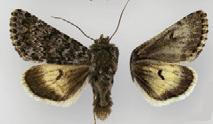
Lasionycta leucocycla is a moth of the family Noctuidae. It can be found in Scandinavia, Siberia and northern North America.

Syngrapha microgamma, the little bride looper moth, is a moth of the family Noctuidae. The species was first described by Jacob Hübner in 1823. It is found in much of Canada south in the east to southern Maine, northern New York, and the Great Lakes states. In Europe, it is found from Fennoscandia and central Europe east to mountains eastern Asia.
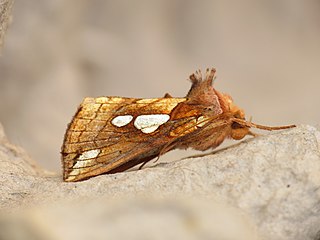
Plusia putnami, the Lempke's gold spot or Putnam's looper moth, is a species of moth of the family Noctuidae. It is found in the Palearctic realm, from Japan and eastern Siberia to Fennoscandia, Great Britain, and France. In North America, it ranges from Newfoundland and Labrador to central Alaska and the interior of British Columbia, south to Pennsylvania, Washington, north-eastern California, and in the Rocky Mountains to Utah and Colorado.

Protolampra sobrina, the cousin german, is a moth of the family Noctuidae. The species was first described by Philogène Auguste Joseph Duponchel in 1843. It is found in most of Europe, then east across the Palearctic to Siberia, Altai, Irkutsk, Kamchatka and Korea.
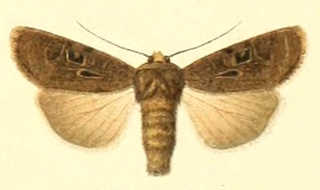
Chersotis andereggii is a moth of the family Noctuidae.

Smerinthus caecus, the northern eyed hawkmoth, is a moth of the family Sphingidae. The species was first described by Édouard Ménétries in 1857.

Colostygia aptata is a moth of the family Geometridae first described by Jacob Hübner in 1813. It is found in most of the Palearctic realm.

Lampropteryx suffumata, the water carpet, is a moth of the family Geometridae. It is found from Europe to the Altai Mountains, Khabarovsk Krai and the Kamchatka Peninsula in the far east of Russia, and Hokkaido, Japan. In 2000, the species was discovered in Alaska, USA, and then in 2008 DNA-barcoding analysis of museum specimens identified several Canadian specimens, thereby extending the geographical range from Ireland in the west, across Eurasia, to the west of North America. The habitat consists of damp woodland, grassy areas, chalk downland and scrubland.

Perizoma hydrata is a species of moth of the family Geometridae. It is found from most of Europe and the Caucasus through western Siberia to the Sayan Mountains and Altai and northern Mongolia.

Mompha sexstrigella is a moth in the family Momphidae. It has a Holarctic distribution. In Europe it is found in northern Fennoscandia and Estonia. It is also found in the Asian part of Russia, where it is known from the Altai mountains, southern Siberia and Sakhalin. In North America, it is found in Canada and the western United States.
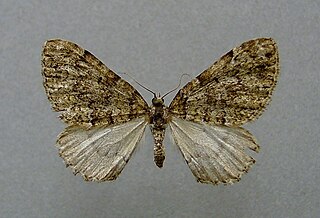
Colostygia kollariaria is a moth of the family Geometridae. It is found in the Alps and the Carpathian Mountains on altitudes between 500 and 2,000 meters.
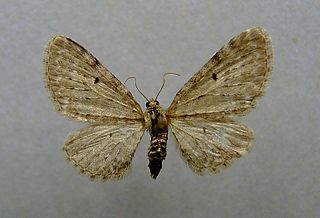
Eupithecia veratraria is a moth of the family Geometridae first described by Gottlieb August Wilhelm Herrich-Schäffer in 1848. It is found from the mountainous areas of Europe and Asia up to Japan.
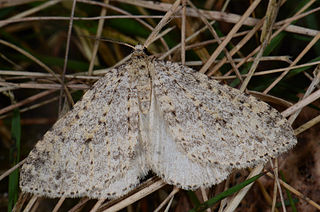
Colostygia multistrigaria, the mottled grey, is a species of moth in the family Geometridae. It is found in western and south-western Europe and North Africa. The habitat is damp woodlands, heaths, and mosses.

Panchrysia aurea is a moth of the family Noctuidae. It is found in southern Europe and western and central Asia. The range extends from Portugal, east to Tian Shan, the Altai and the north-western Himalayas. In central Europe, it is found in the southern Alps, lower Austria and the mountains on the Balkan Peninsula.


















